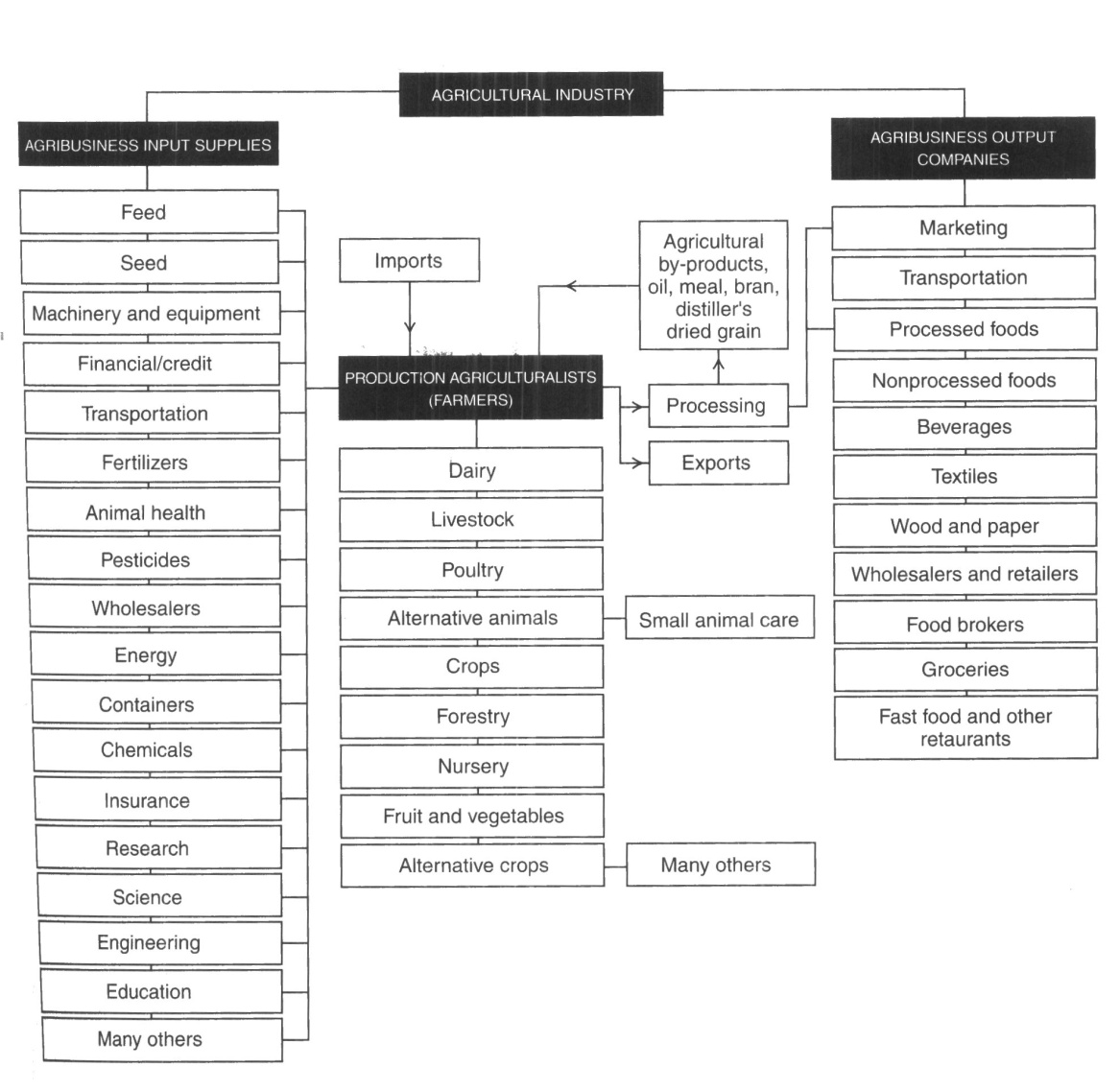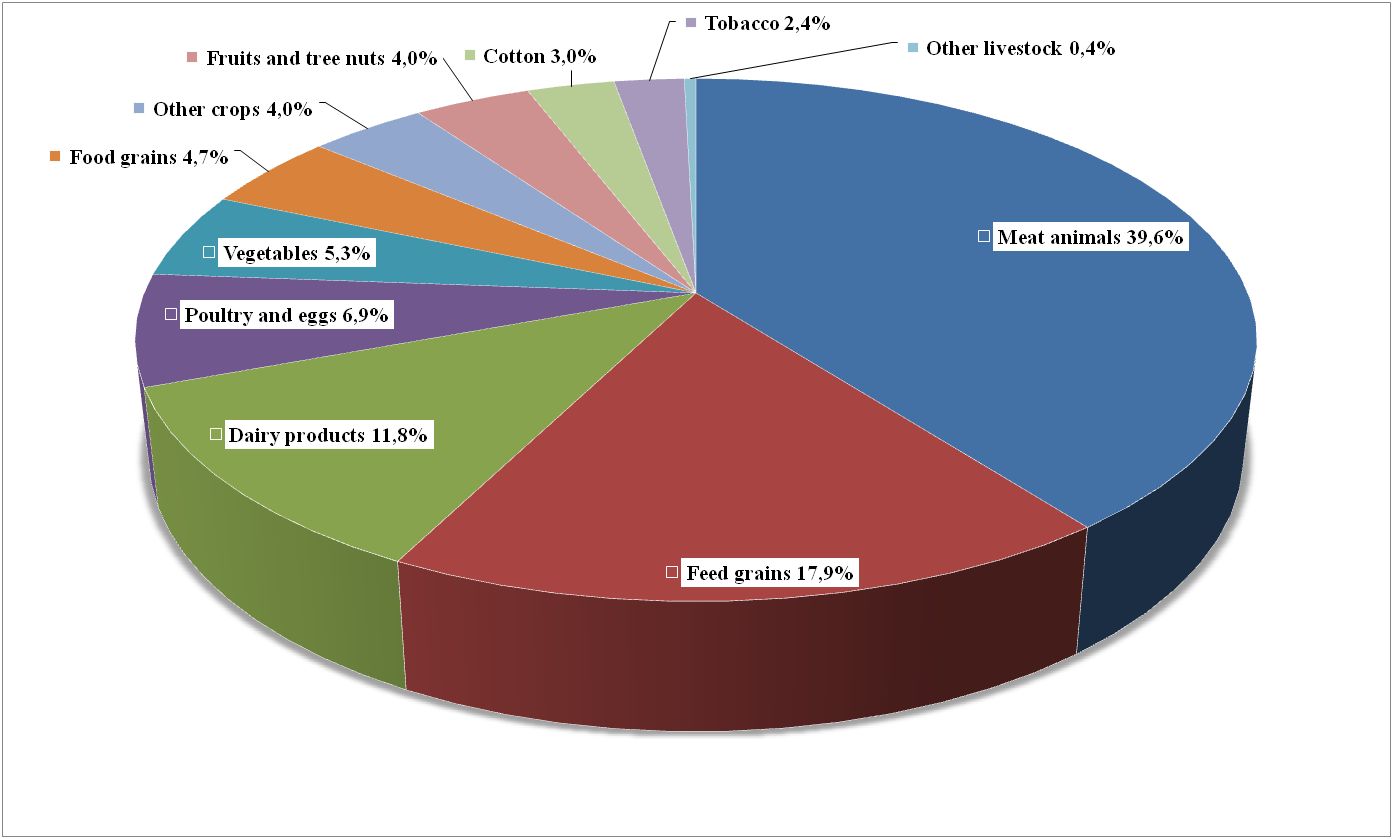
- •Unit 1 agribusiness defined
- •Look at the graph. Discuss the composition of agribusiness. Compile a list of businesses at your locality that fit this graph.
- •Current condition of american agribusiness
- •Fill the blanks according to the text
- •Compare figures 1 and 2. How could you characterize domestic and global agricultural markets of the usa?
- •Find the synonyms
- •Define the following terms
- •Translate the texts into English. List the keywords. Make the English summary of the first text. Российский агробизнес
- •Инвесторы с надеждой смотрят на российский агробизнес
Unit 1 agribusiness defined
Look at the graph. Discuss the composition of agribusiness. Compile a list of businesses at your locality that fit this graph.

Translate the text paying attention to the words in the bold type.
Current condition of american agribusiness
When most people think of agriculture, they picture farmers producing animals and crops. Agriculture is often thought of as "cows, sows, and plows" or "weeds, seeds, and feeds." But agriculture has changed. For years agriculture was farming. Nearly everyone lived on farms, and farmers were self-sufficient. Very few manufactured supplies and materials were available. Today, however, agriculture is a technology-oriented industry that includes production, agriscience, and agribusiness.
Most people who work in the agricultural industry do not work on farms and ranches but rather are employed in the feed, seed, farm machinery, fertilizer, chemical supply, and food-processing businesses. There are also many agribusiness workers in finance, distribution, and marketing firms who provide service to production agriculturalists. Agriculture is large business. There are many different definitions of agribusiness. Some people interpret the word narrowly to mean only very large businesses within the agricultural industry. Other scientists defined it as the sum total of all operations involved in the manufacture and distribution of farm supplies; production operations on the farm; and the storage, processing, and distribution of the resulting farm commodities and items. A similar definition of agribusiness describes it as any profit-motivated enterprise that involves providing agricultural supplies and/or the processing, marketing, transporting, and distributing of agricultural materials and consumer products. In its broad meaning agribusiness is defined as the coordinating science of supplying agricultural production inputs and subsequently producing, processing, and distributing food and fiber.
Agribusiness companies provide input supplies to the production agriculturalist (farmer). The farmer produces food and fiber (cotton, wool, etc.), and the output is taken by agribusiness companies that process, market, and distribute the agricultural products.
Many services are needed in agriculture, such as transportation, storage, refrigeration, credit, finance, and insurance. Agribusiness manufacturers furnish farmers with supplies and equipment needed to produce and protect their crops. Government agencies inspect and grade agricultural products to ensure quality and safety. Hundreds of agribusiness trade organizations, commodity organizations, committees, and conferences educate, promote, advertise, coordinate, and lobby for their agricultural products. Science, research, engineering, and education help improve agribusiness. Millions of people are employed in agribusiness throughout the world, and people throughout the world also depend on agribusiness for their food, clothing, and shelter.
Today the efficiency of the farmer is so great that less than 2.5 percent of the American population is actively involved in the production of food or fiber.
Because farming and agribusinesses are often presented as the same thing, distorted pictures of the agricultural industry are reinforced. For example, because the number of farms has been decreasing for a number of years, many people have concluded that the agricultural industry is declining. Mistakenly, high school counselors often advise students that opportunities in agricultural occupations are declining because, they note, the number of farmers is decreasing. However, they do not take into consideration the fact that agricultural exports and imports and agricultural inputs and outputs are at all-time highs.
Today's modern agricultural industry of farmers, agrisciences. and agribusinesses encompasses an extremely massive and complex group of organizations and the people who run them.
There could be no agribusiness without production agriculture. It all starts with the land. Goods from the earth come from the kind, from farms and the hard work of farmers.1 Day by day, the role of the American farmers becomes more important as more and more people are becoming dependent upon them.
Because land is the major resource in modern farming, Americans are especially interested in how much is available and how it is being used. The United States has about 2.3 billion acres. About 21 percent of the land is used for crops, 25 percent for livestock, and 30 percent for producing forest products. The remaining 26 percent is used for nonagricultural purposes.
Some people contend that because of increasing nonagricultural uses of land, Americans are running out of good farmland. The facts do not support this conclusion. Even though the number of acres of farmland is decreasing, the economic land base is increasing. The productivity of land is increasing faster than the acres are decreasing.
Farm numbers have declined since the 1920s, but at different rates. Currently, about 2.1 million farms are producing the total food supply for Americans and numerous foreign countries. Although farm numbers are decreasing, the average size of farms is increasing. Currently, the average American farm is 469 acres. his means that most farms that go out of business are bought by other farmers. Economists predict that the trend toward fewer farms will continue, but the decrease will occur in small- and medium-sized farms. Larger farms are expected to increase in number and volume of sales. Presently, about 169,000 farms contain 1,000 acres or more; 200.000 farms contain 500 to 1.000 acres: over 700,000 farms have 10 to 100 acres; and approximately 1 8 3,000 farms have less than 10 acres.
Look through the text. Find the keywords.Translate the text paying attention to the words in the bold type.
THE IMPORTANCE OF AGRIBUSINESS FOR US ECONOMY
To see the impact of production agriculture on the U.S. economy, Americans need to reference the yardstick that measures the value of goods and services that America produces in a year, the gross domestic product (GDP). The agricultural industry accounts for 17 percent of the GDP and provides more than 20 percent of all the jobs in the country. Two percent of the GDP comes from firms or people that sell goods and services to farmers. However, 13 percent of the GDP comes from related industries. These related industries include ice cream makers, textile mills, flour mills, tanneries, breakfast food makers, and a host of others. These related industries purchase food and fiber from farmers and then process and package it so they will have a value- added product to sell to consumers.
Last year America's GDP was $8.5 trillion, and the agricultural industry accounted for 17 percent, which comes to an impressive $936 billion to place the $936 billion in perspective, it would be enough money to feed the entire U.S. population for almost five years.
The products produced by farmers are very diverse. The relative percentages of the various farm products, from farmer estimates, are shown in the Figure 1. There are many kinds of farmers in America, depending on conditions such as the type of soil, the topography, the climate, rainfall, and markets.

The animal enterprises with the greatest value of production for the United States are beef cattle and calves, dairy cattle, hogs, and poultry. The leading plant enterprises, in value and production, in America are corn for grain, soybeans, wheat, and cotton. Among the fruits, the leaders are grapes, oranges, and apples. Almonds are the leader in the nut category. The farmers' share of each dollar spent for
Figure 1. America’s farming enterprises
food by the consumer is about 30 cents. This means that approximately 70 cents of every dollar the consumer spends for food products go to pay the cost of transportation, processing, other marketing services, and profits after the products leave the hands of the farmer. Currently, farmers take in about $1 50 billion a year from the sale of farm products, plus another $45 billion from off-farm sources.
The agribusiness output sector includes all agribusiness and individuals that handle agricultural products from the farm to the final consumer. This includes agribusinesses involved in buying, transporting, storing, warehousing, grading, sorting, processing, assembling, packing, selling, merchandising, insuring, regulating, inspecting, communicating, advertising, and financing. Restaurants, fast foods chains, and grocery stores are also a part of the agribusiness output sector. Figure 2-6 illustrates a few of the various agribusinesses involved in the output sector.
The agribusiness output sector needs approximately 20 million workers to handle the output of the nation's farms. The following are examples of where these workers are employed:
The USDA estimates that over 600,000 businesses are involved in marketing food products. Nearly $42 5 billon was spent by consumers for food products alone within the agribusiness output sector. This represents about 9 percent of the consumers' disposable personal income. in America the agriservices sector of the agriculture industry is concerned with researching new and better ways to produce and market food and to protect food producers and consumers, and with providing special, custom-type services to all the other phases of agriculture. Public agencies have played a dominant role in the agriservices area, but private agencies are increasing their offerings of farm services at a rapid pace.
The public agriservices group provides special services at the federal, state, and local levels. The major areas of emphasis include research, education, communication, and regulation. There are over 100,000 employees in the USDA, 12,000 of whom work in Washington, D.C. Often their work is closely allied to that of state and county agricultural workers. Some 17,500 employees work in the state and federal extension services, and 24,000 more are attached to the state agricultural experiment stations. About 25,000 county committee persons administer the agricultural programs established by Congress.17 There are approximately 12,000 teachers of agricultural education. Other public agriservices include the Food and Drug Administration; Department of the Interior, which includes the National Park Service; and a small portion of the Department of Commerce.
Recently, according to the USDA, farmers paid more than $ 1 billion yearly for private agriservices such as veterinary care, feed grinding and mixing, machine harvesting, contract labor, and spraying. Over 30,000 firms provide agricultural services, some of which are nonfarm. This group employs over 100,000 workers and has a payroll of about $600 million. This does not include about 30,000 nonpaid owners and family members and other part-time workers.
